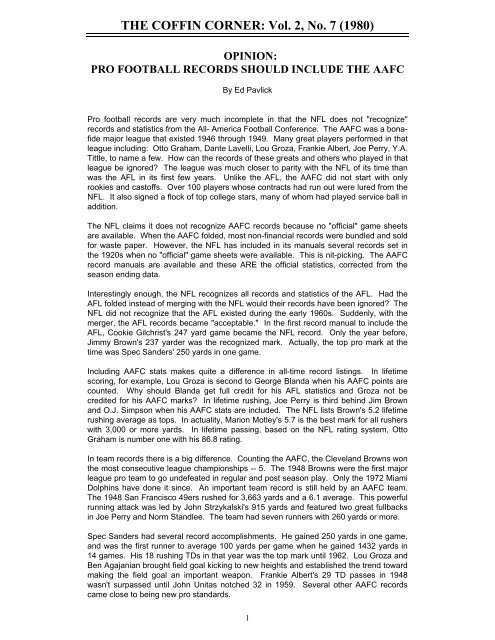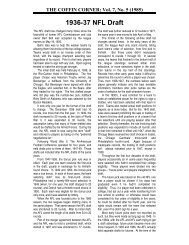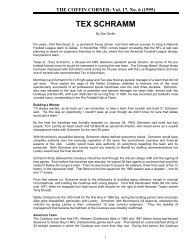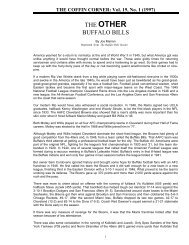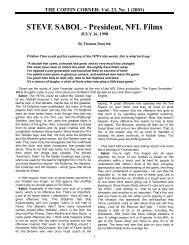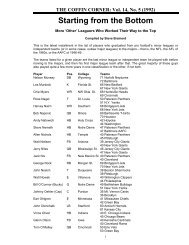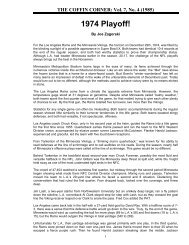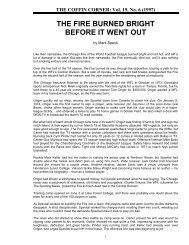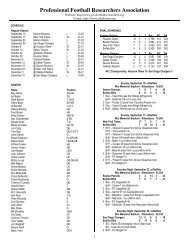THE COFFIN CORNER: Vol. 2, No. 7 - Professional Football ...
THE COFFIN CORNER: Vol. 2, No. 7 - Professional Football ...
THE COFFIN CORNER: Vol. 2, No. 7 - Professional Football ...
You also want an ePaper? Increase the reach of your titles
YUMPU automatically turns print PDFs into web optimized ePapers that Google loves.
<strong>THE</strong> <strong>COFFIN</strong> <strong>CORNER</strong>: <strong>Vol</strong>. 2, <strong>No</strong>. 7 (1980)<br />
OPINION:<br />
PRO FOOTBALL RECORDS SHOULD INCLUDE <strong>THE</strong> AAFC<br />
By Ed Pavlick<br />
Pro football records are very much incomplete in that the NFL does not "recognize"<br />
records and statistics from the All- America <strong>Football</strong> Conference. The AAFC was a bonafide<br />
major league that existed 1946 through 1949. Many great players performed in that<br />
league including: Otto Graham, Dante Lavelli, Lou Groza, Frankie Albert, Joe Perry, Y.A.<br />
Tittle, to name a few. How can the records of these greats and others who played in that<br />
league be ignored? The league was much closer to parity with the NFL of its time than<br />
was the AFL in its first few years. Unlike the AFL, the AAFC did not start with only<br />
rookies and castoffs. Over 100 players whose contracts had run out were lured from the<br />
NFL. It also signed a flock of top college stars, many of whom had played service ball in<br />
addition.<br />
The NFL claims it does not recognize AAFC records because no "official" game sheets<br />
are available. When the AAFC folded, most non-financial records were bundled and sold<br />
for waste paper. However, the NFL has included in its manuals several records set in<br />
the 1920s when no "official" game sheets were available. This is nit-picking. The AAFC<br />
record manuals are available and these ARE the official statistics, corrected from the<br />
season ending data.<br />
Interestingly enough, the NFL recognizes all records and statistics of the AFL. Had the<br />
AFL folded instead of merging with the NFL would their records have been ignored? The<br />
NFL did not recognize that the AFL existed during the early 1960s. Suddenly, with the<br />
merger, the AFL records became "acceptable." In the first record manual to include the<br />
AFL, Cookie Gilchrist's 247 yard game became the NFL record. Only the year before,<br />
Jimmy Brown's 237 yarder was the recognized mark. Actually, the top pro mark at the<br />
time was Spec Sanders' 250 yards in one game.<br />
Including AAFC stats makes quite a difference in all-time record listings. In lifetime<br />
scoring, for example, Lou Groza is second to George Blanda when his AAFC points are<br />
counted. Why should Blanda get full credit for his AFL statistics and Groza not be<br />
credited for his AAFC marks? In lifetime rushing, Joe Perry is third behind Jim Brown<br />
and O.J. Simpson when his AAFC stats are included. The NFL lists Brown's 5.2 lifetime<br />
rushing average as tops. In actuality, Marion Motley's 5.7 is the best mark for all rushers<br />
with 3,000 or more yards. In lifetime passing, based on the NFL rating system, Otto<br />
Graham is number one with his 86.8 rating.<br />
In team records there is a big difference. Counting the AAFC, the Cleveland Browns won<br />
the most consecutive league championships -- 5. The 1948 Browns were the first major<br />
league pro team to go undefeated in regular and post season play. Only the 1972 Miami<br />
Dolphins have done it since. An important team record is still held by an AAFC team.<br />
The 1948 San Francisco 49ers rushed for 3,663 yards and a 6.1 average. This powerful<br />
running attack was led by John Strzykalski's 915 yards and featured two great fullbacks<br />
in Joe Perry and <strong>No</strong>rm Standlee. The team had seven runners with 260 yards or more.<br />
Spec Sanders had several record accomplishments. He gained 250 yards in one game,<br />
and was the first runner to average 100 yards per game when he gained 1432 yards in<br />
14 games. His 18 rushing TDs in that year was the top mark until 1962. Lou Groza and<br />
Ben Agajanian brought field goal kicking to new heights and established the trend toward<br />
making the field goal an important weapon. Frankie Albert's 29 TD passes in 1948<br />
wasn't surpassed until John Unitas notched 32 in 1959. Several other AAFC records<br />
came close to being new pro standards.<br />
1
<strong>THE</strong> <strong>COFFIN</strong> <strong>CORNER</strong>: <strong>Vol</strong>. 2, <strong>No</strong>. 7 (1980)<br />
It seems unrealistic as well as unfair that the NFL ignores the AAFC in view that other<br />
authorities do indeed recognize them. The Pro <strong>Football</strong> Hall of Fame includes the AAFC<br />
marks in its "lifetime leaders" listings. Two definitive works on pro football -- Treat's<br />
Encyclopedia of <strong>Football</strong> and Sports Encyclopedia: Pro <strong>Football</strong> -- both include AAFC<br />
records, as does the Sporting News' National <strong>Football</strong> Guide. It is interesting to note that<br />
all baseball guides, record books and encyclopedias recognize defunct major leagues<br />
such as the American Association, Union Association and Player's League. All players<br />
who played in those leagues are given full credit for their service and statistics.<br />
Seymour Siwoff, the NFL's official statistician, is also responsible for The Book of<br />
Baseball Records. In it, he includes all the defunct leagues mentioned above and gives<br />
full credit to all players who performed in those leagues. Yet he does not do so for the<br />
AAFC players in the NFL Record Manual.<br />
I believe that P.F.R.A. should campaign for AAFC records and statistical recognition.<br />
Both the NFL and the media must recognize it as an historical fact. Those media people<br />
who fail to include AAFC records in their commentaries should be corrected by P.F.R.A.<br />
members. The players who performed in the AAFC deserve full credit for their entire<br />
careers in pro football.<br />
<strong>No</strong>te: The Editor of The Coffin Corner strongly disagrees with the premise set forth in this<br />
article. As an AAFC fan, he is all for granting any due recognition to players from that late and<br />
lamented league. However, he fails to understand why the NFL should recognize as an NFL<br />
record a record not achieved in the NFL. That’s what the author is advocating. Entities which<br />
recognize “pro football” records (such as the Pro <strong>Football</strong> Hall of Fame) all include the AAFC.<br />
Entities which recognize “NFL records only” (such as the annual NFL Record & Fact Book) do<br />
not include the AAFC. To us, this makes perfect sense.<br />
2


